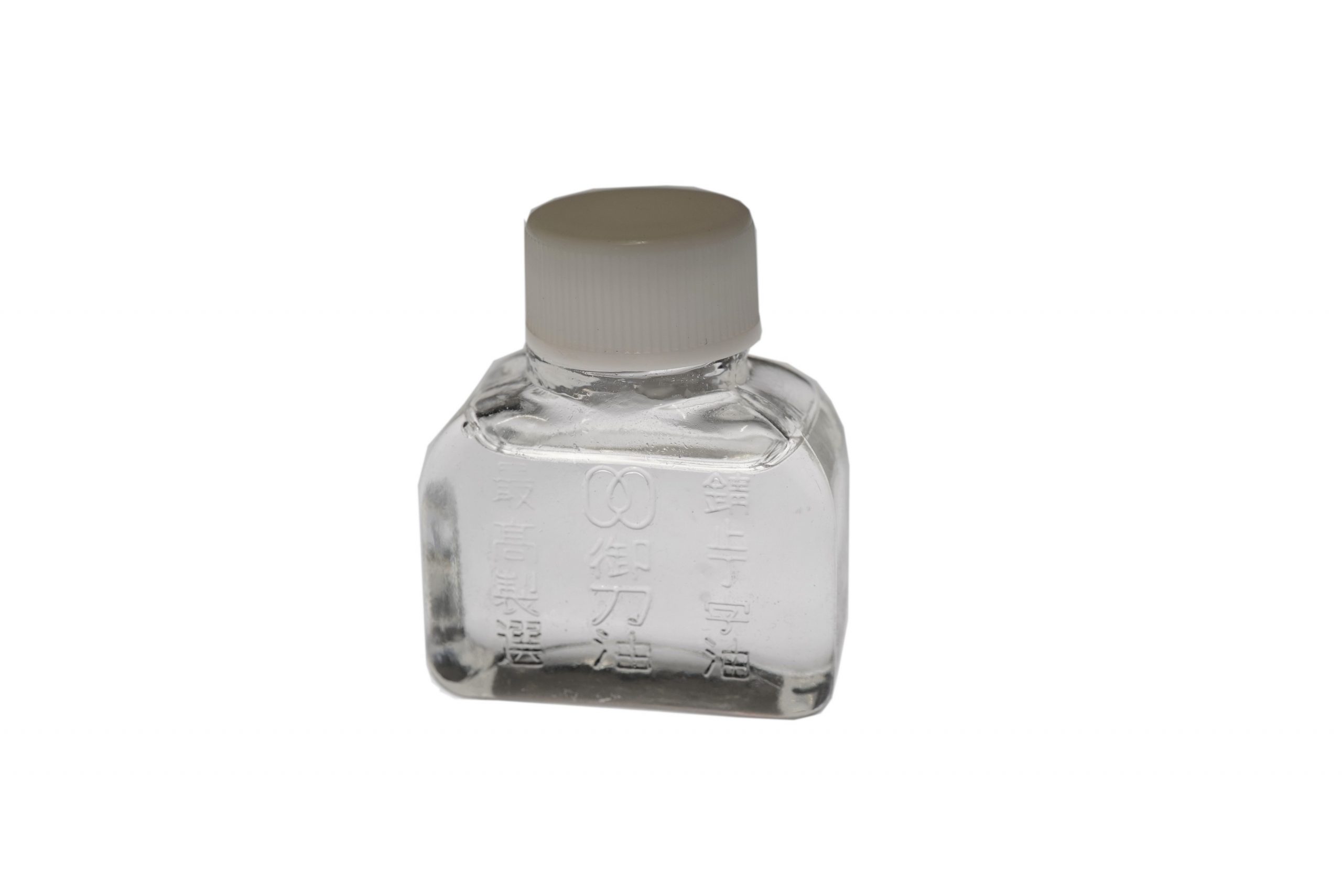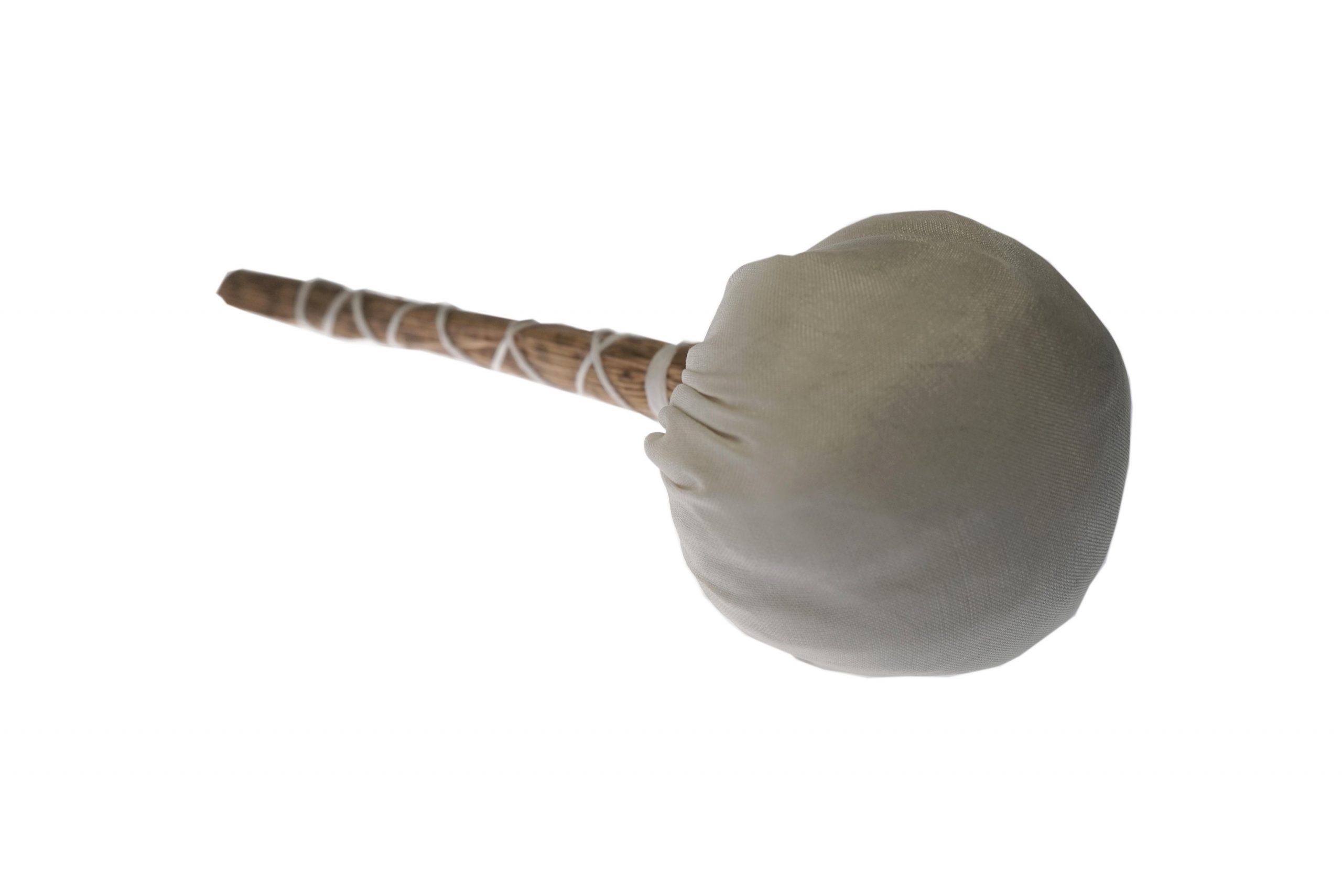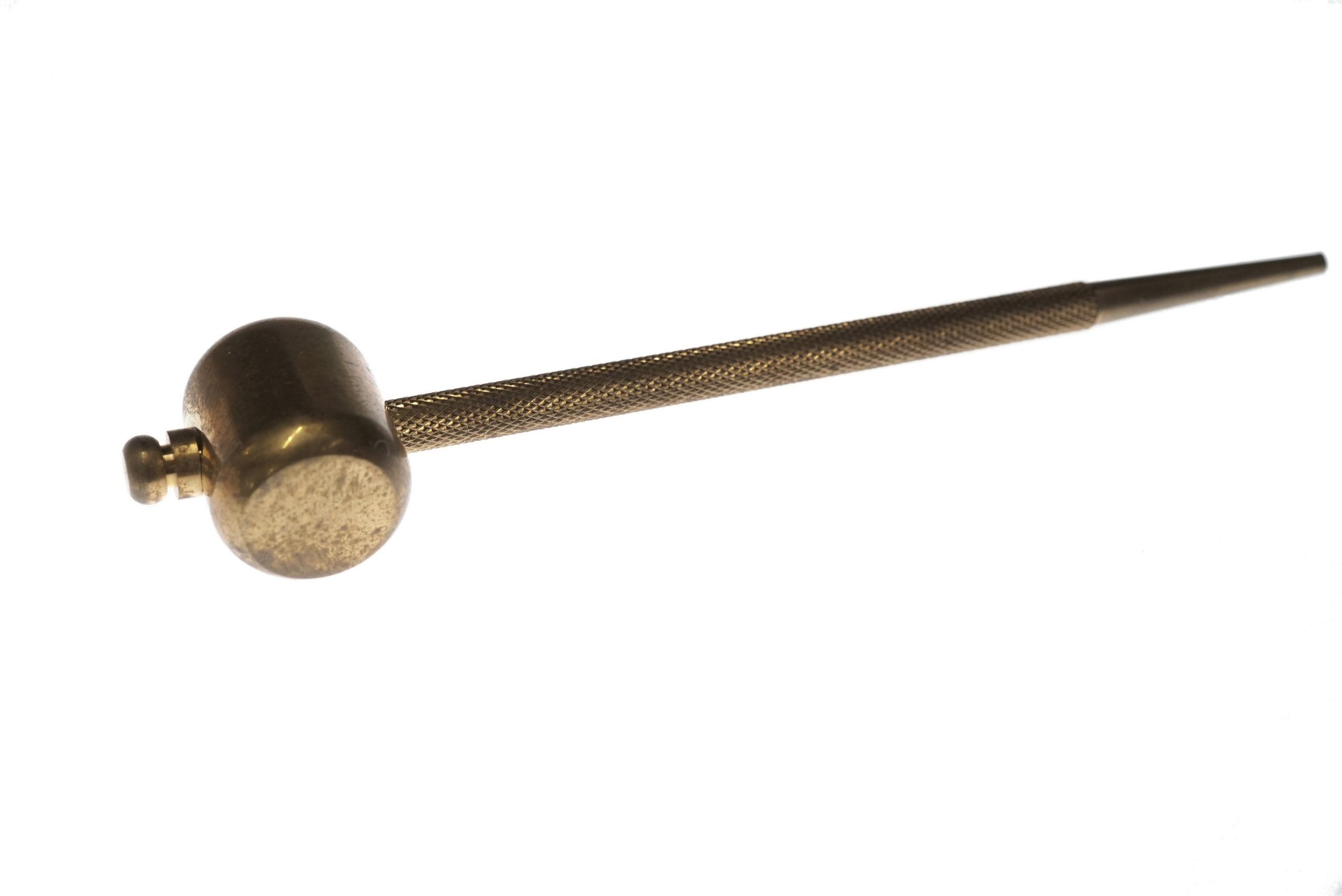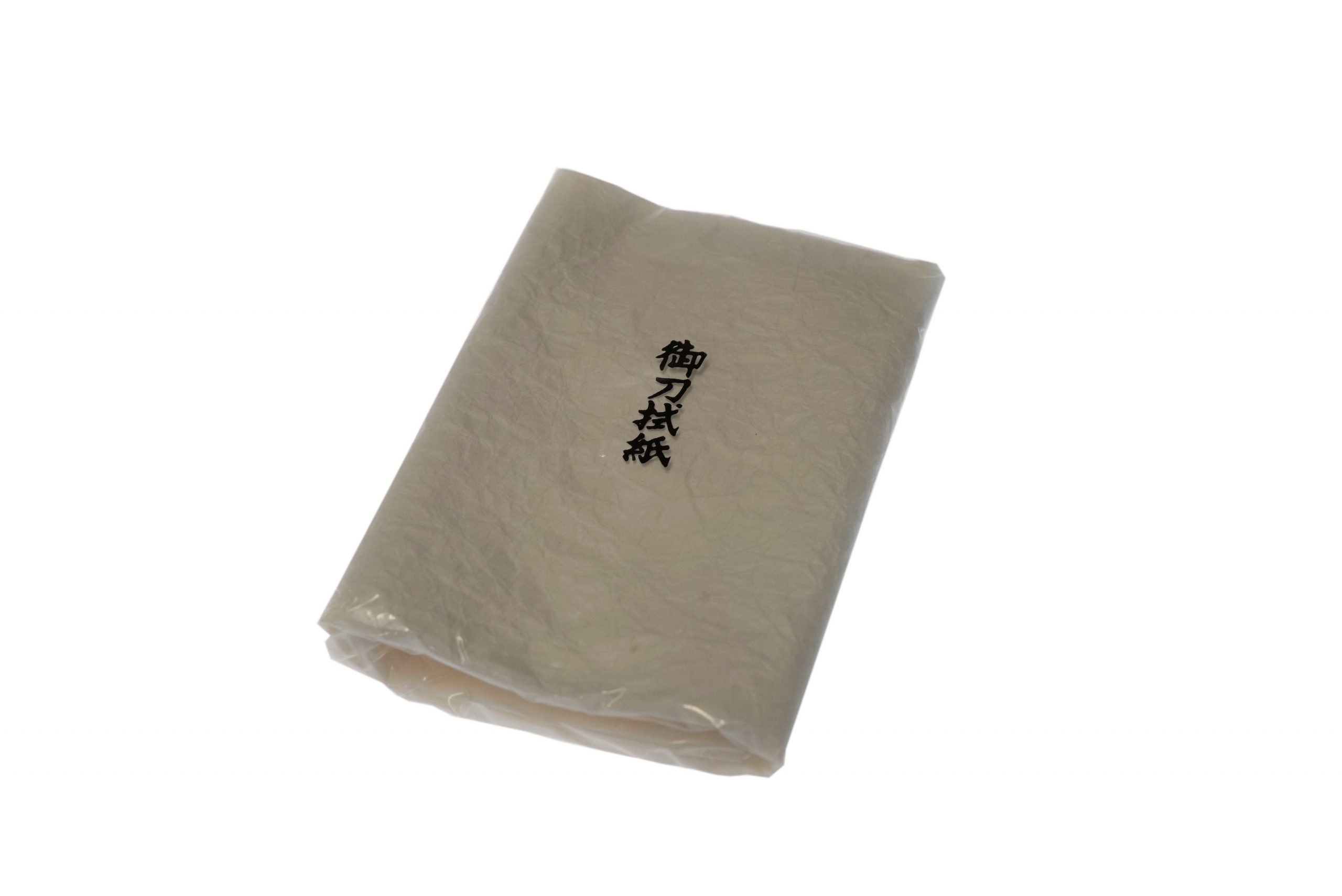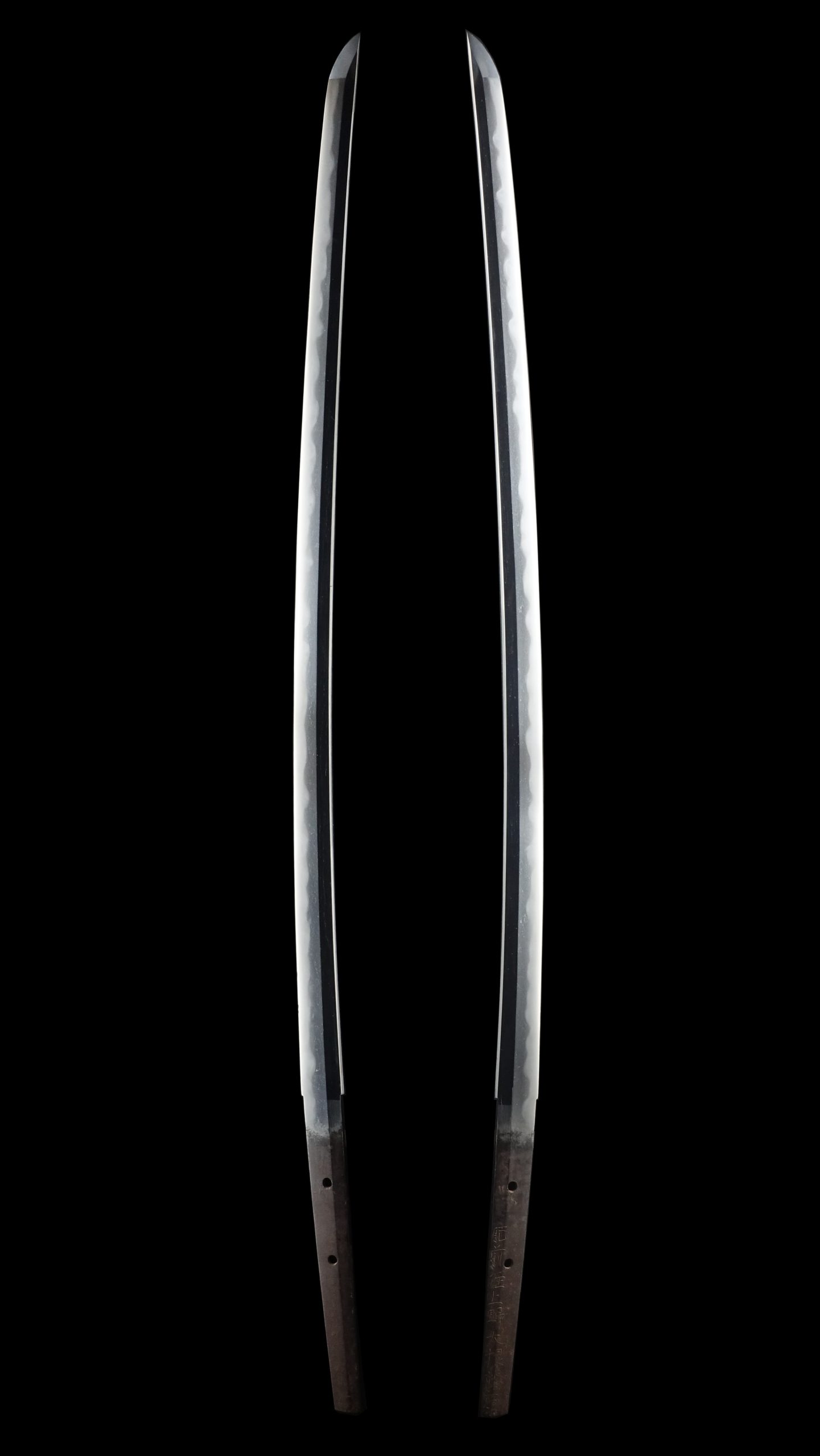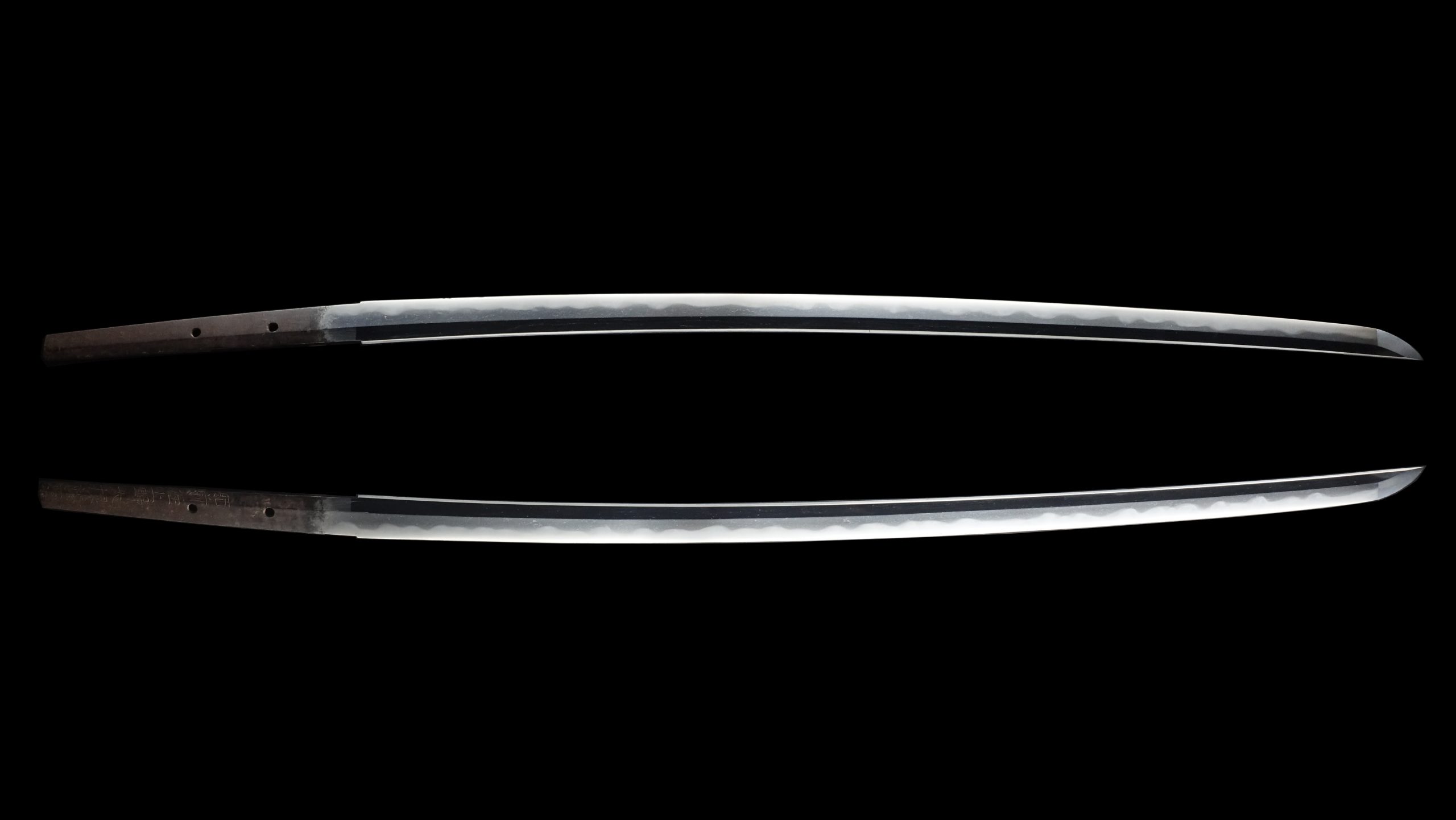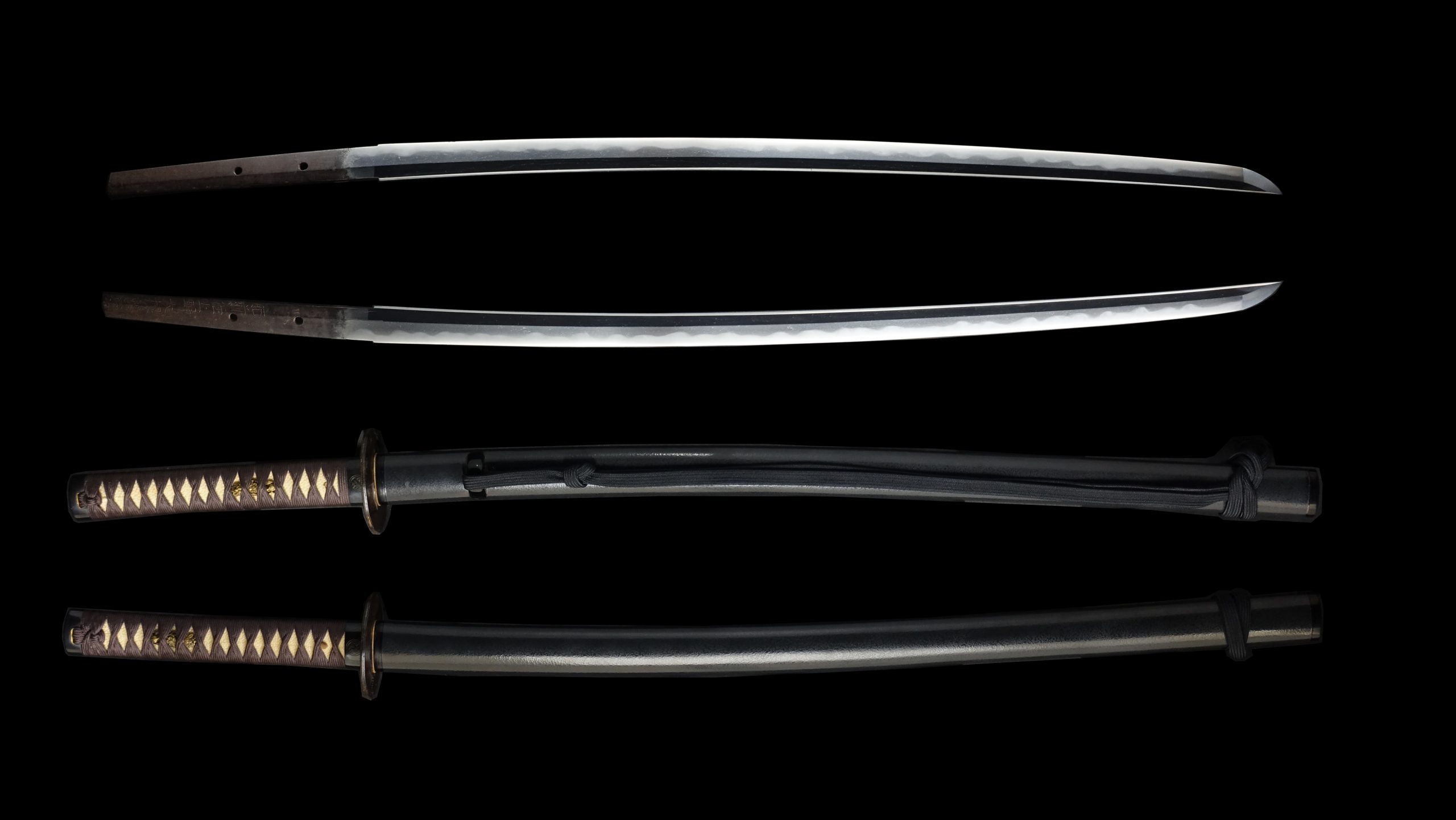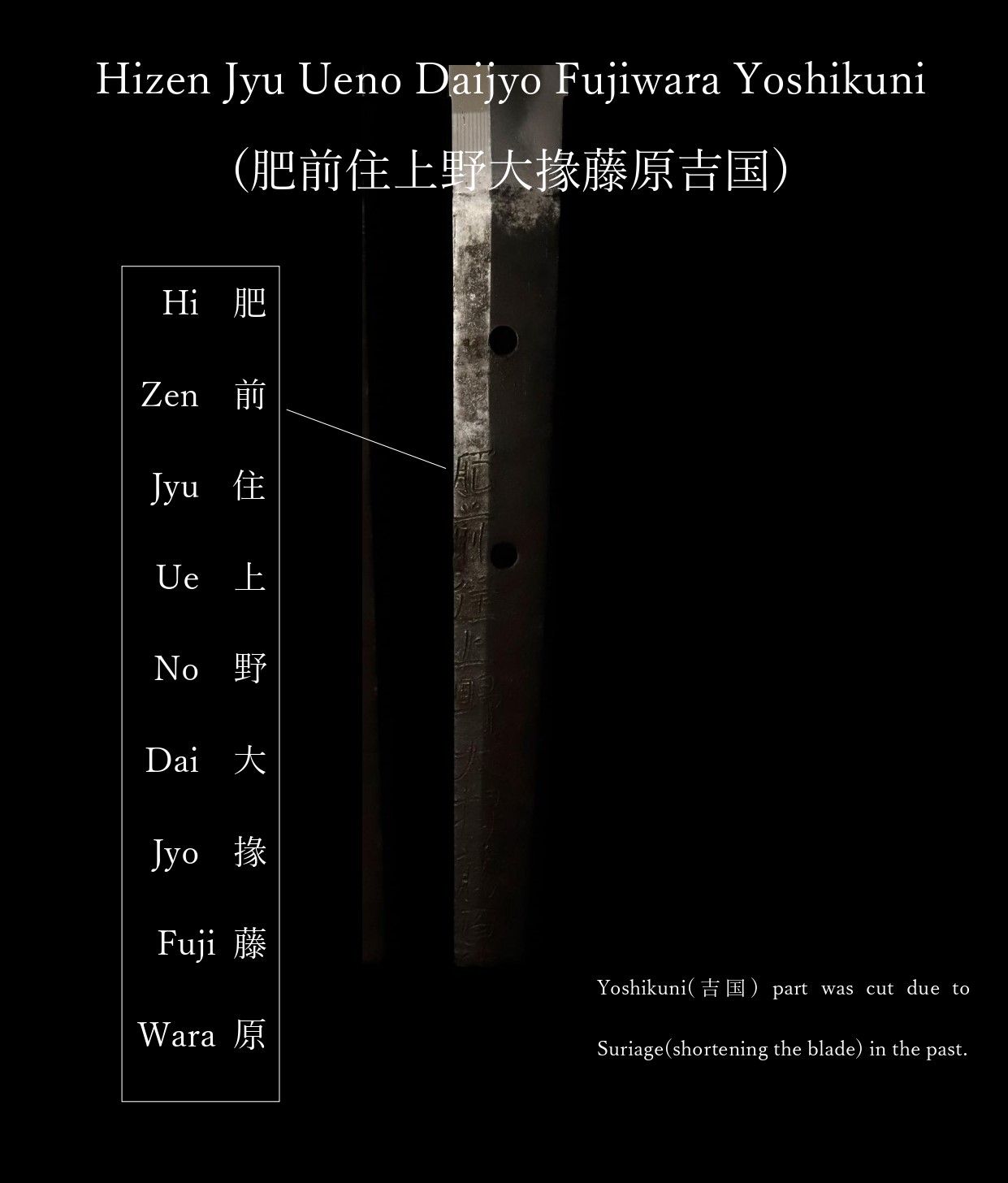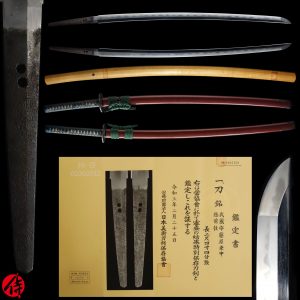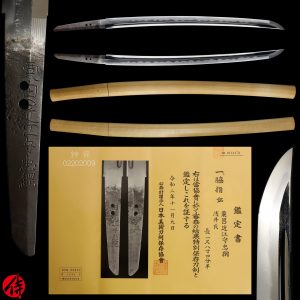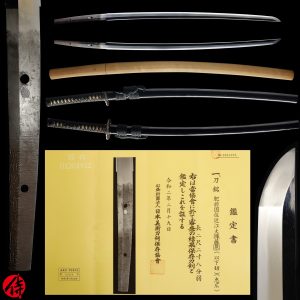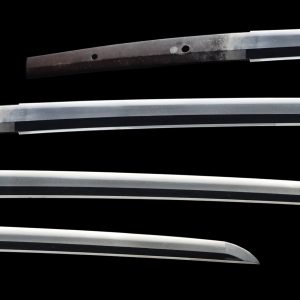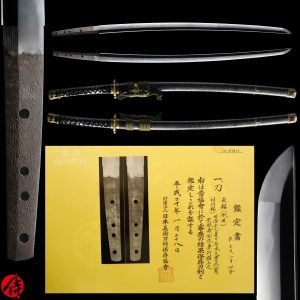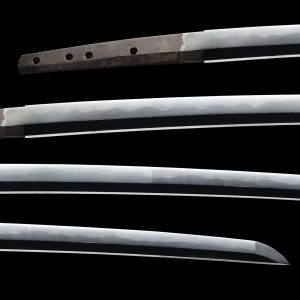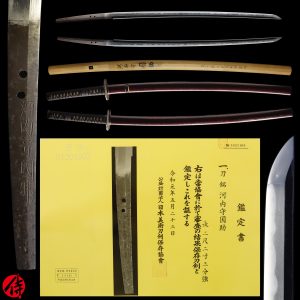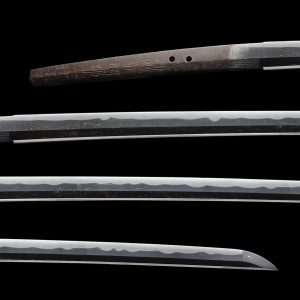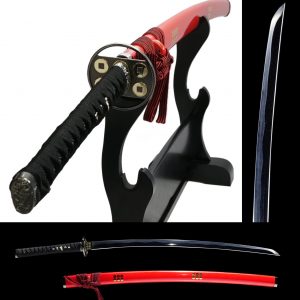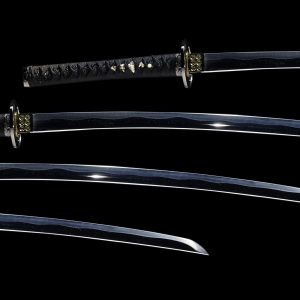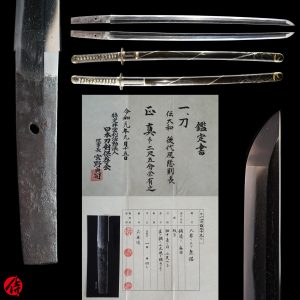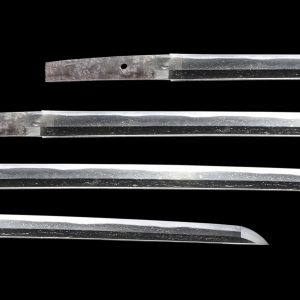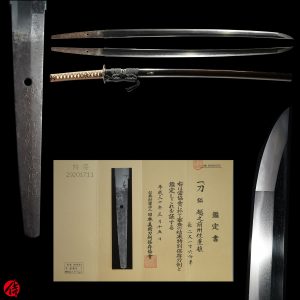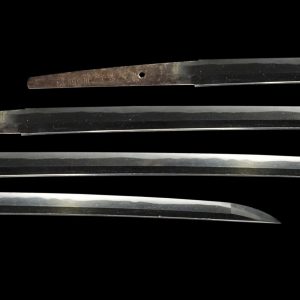Antique Japanese Sword Katana Signed by Yoshikuni with Hozon Certificate
【Description】
This blade was signed by Hizen Jyu Ueno Daijyo Fujiwara Yoshikuni(肥前住上野大掾藤原吉国) while “Yoshikuni” part was cut due to the size adjustment(Suriage) in the past. Hizen, located in Saga prefecture, is the name of the place where Yoshikuni forged this blade. Ueno Daijyo is a honorable title given to skilled swordsmiths in Samurai history. Fujiwara Yoshikuni is his maker’s name.
He was active in sword forging in the early Edo period(Kanbun era: 1661-1673). He was the son of Fujiwara Kunihiro(藤原国広). Fujiwara Kunihiro was the son of Hirosada, who was the younger brother of the first-gen Tadayoshi. Tadayoshi is regarded as one of the greatest swordsmiths in the early Edo period in Japanese sword history. Yoshikuni was related to this swordsmith.
Yoshikuni was serving for the Nabeshima clan, forging swords for the feudal family. Nabeshima clan ruled Hizenkoku during the Edo period, which indicates that Yoshikuni served a powerful feudal lord.
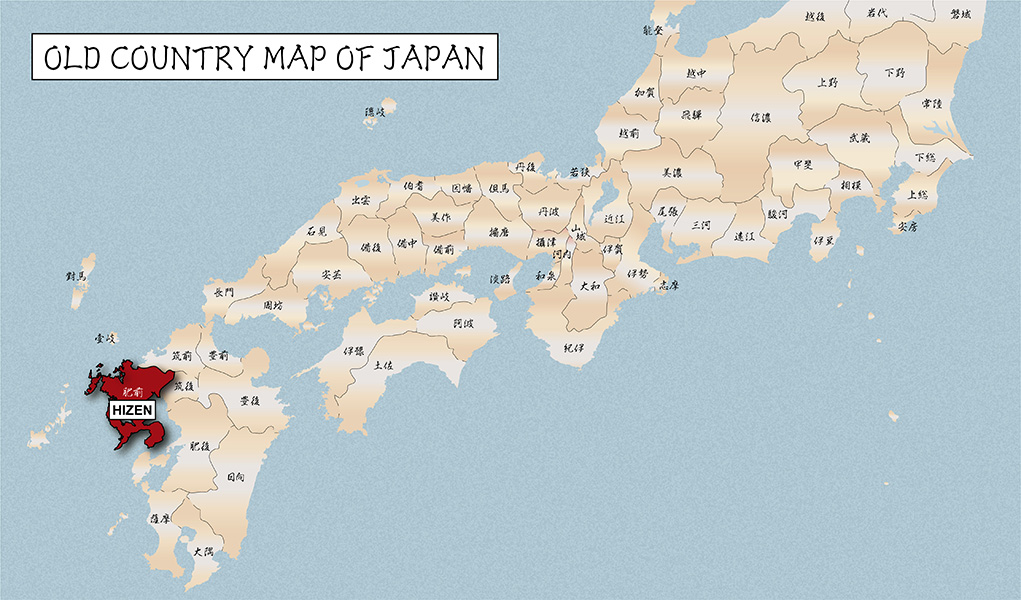
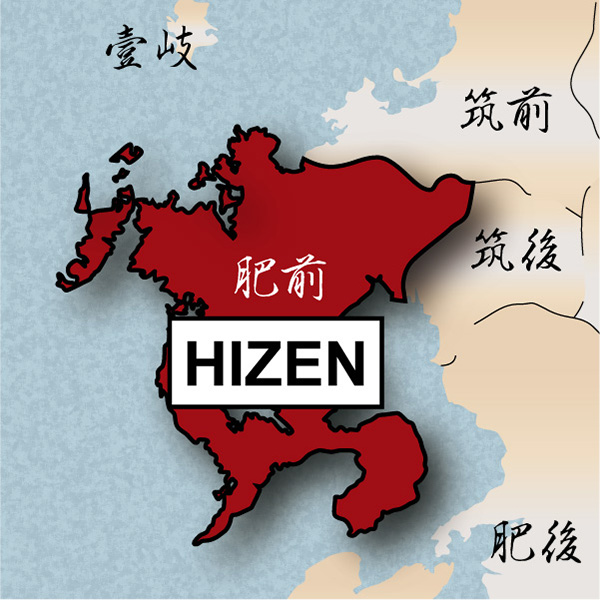
The swordsmiths in the Hizen province worked under the auspices of the Nabeshima clan like Yoshikuni. They were able to produce beautiful Jigane-patterned blades, also known as Hizen To, using and mixing carbon steel made in western countries. Hizenkoku had been flourishing by international trading. The geographic location of this domain made it possible to have easy access to western carbon steel.
This blade is appraised as a Hozon Token(保存刀剣) issued by NBTHK(Nihon Bijutsu Touken Hozon Kyokai:日本美術刀剣保存協会). This authentication paper was only given to authentic Japanese swords, well preserved with artistic value.
There is a tiny rust spot on this blade and a small Kizu on Mune(backbone of the blade). If you like to make sure of the condition, please feel free to contact us. We will send you detailed photos.
【 Blade】
Cutting Edge Length(Nagasa): 69.8 cm( 27.48 inches)
Curvature(Sori):0.14 cm( 0.055 inches)

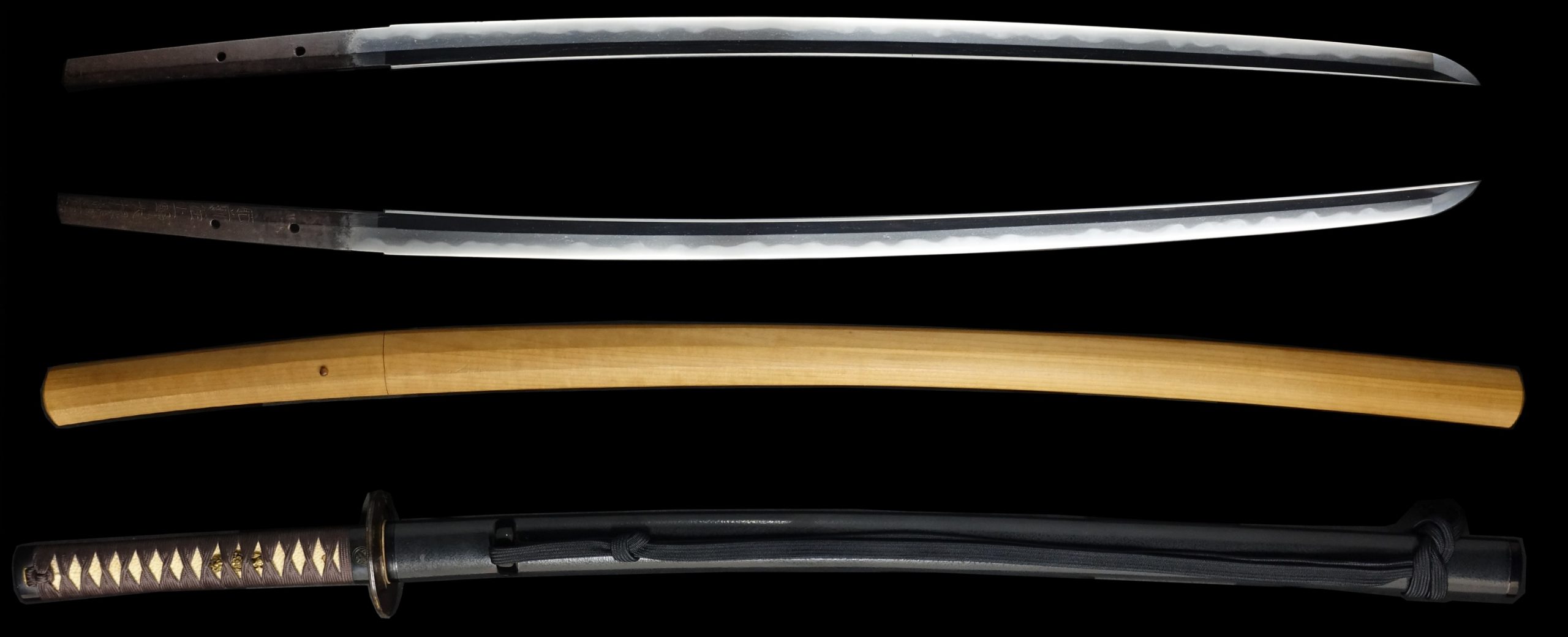
Hamon:
The crystalline structure which forms along the cutting edge of a blade as a result of the hardening process
Jimon(Jihada):
visible steel surface pattern created by folding and hammering during forging process
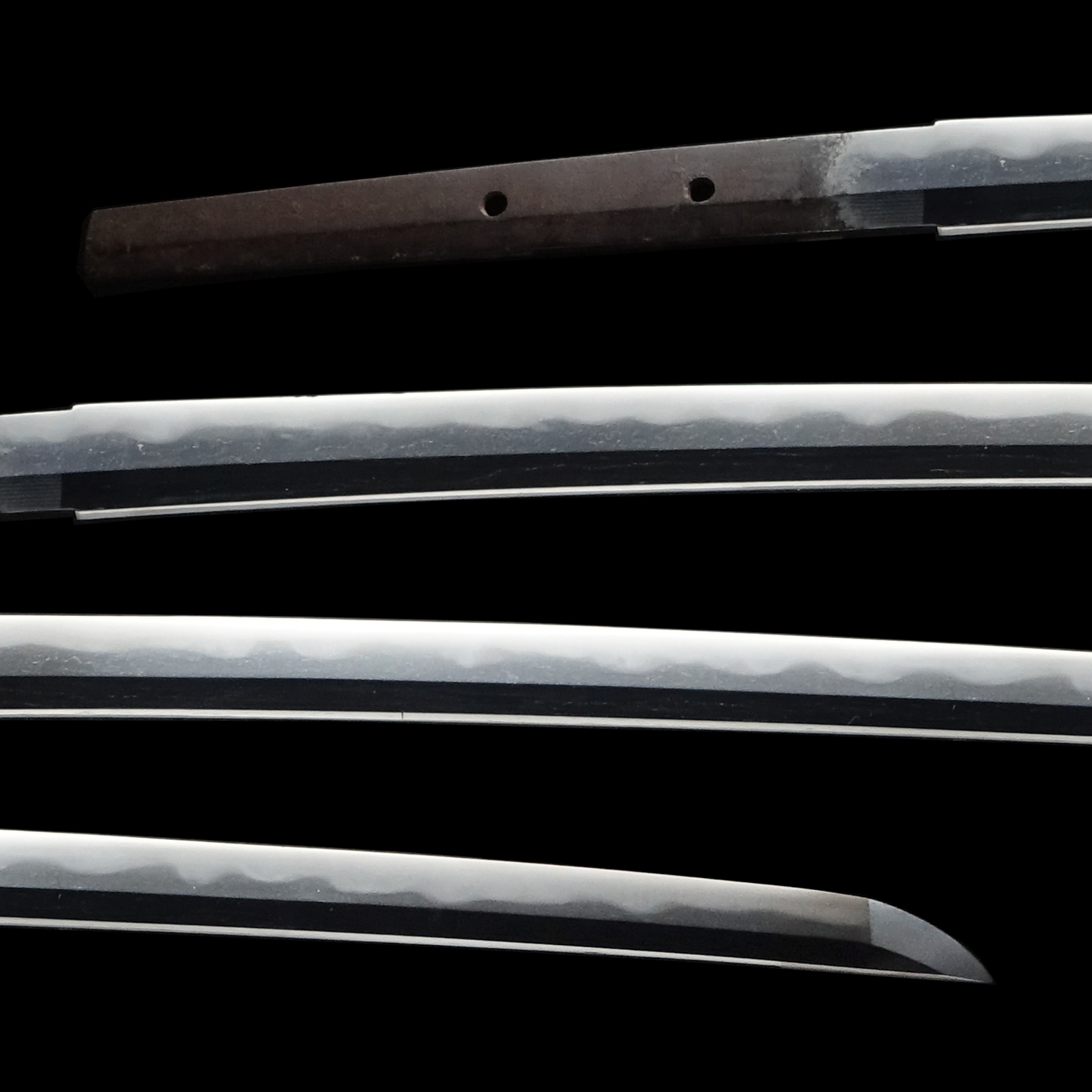

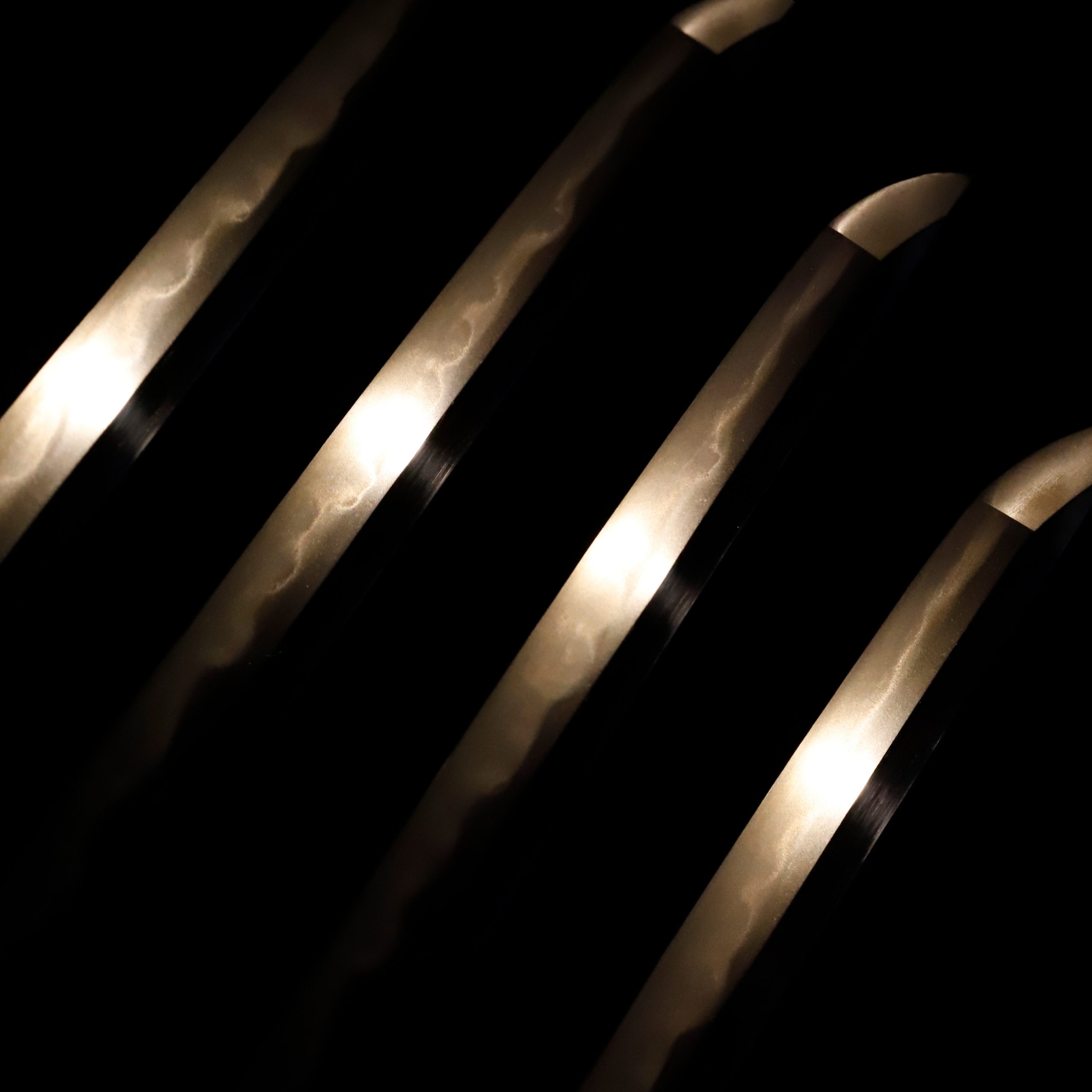
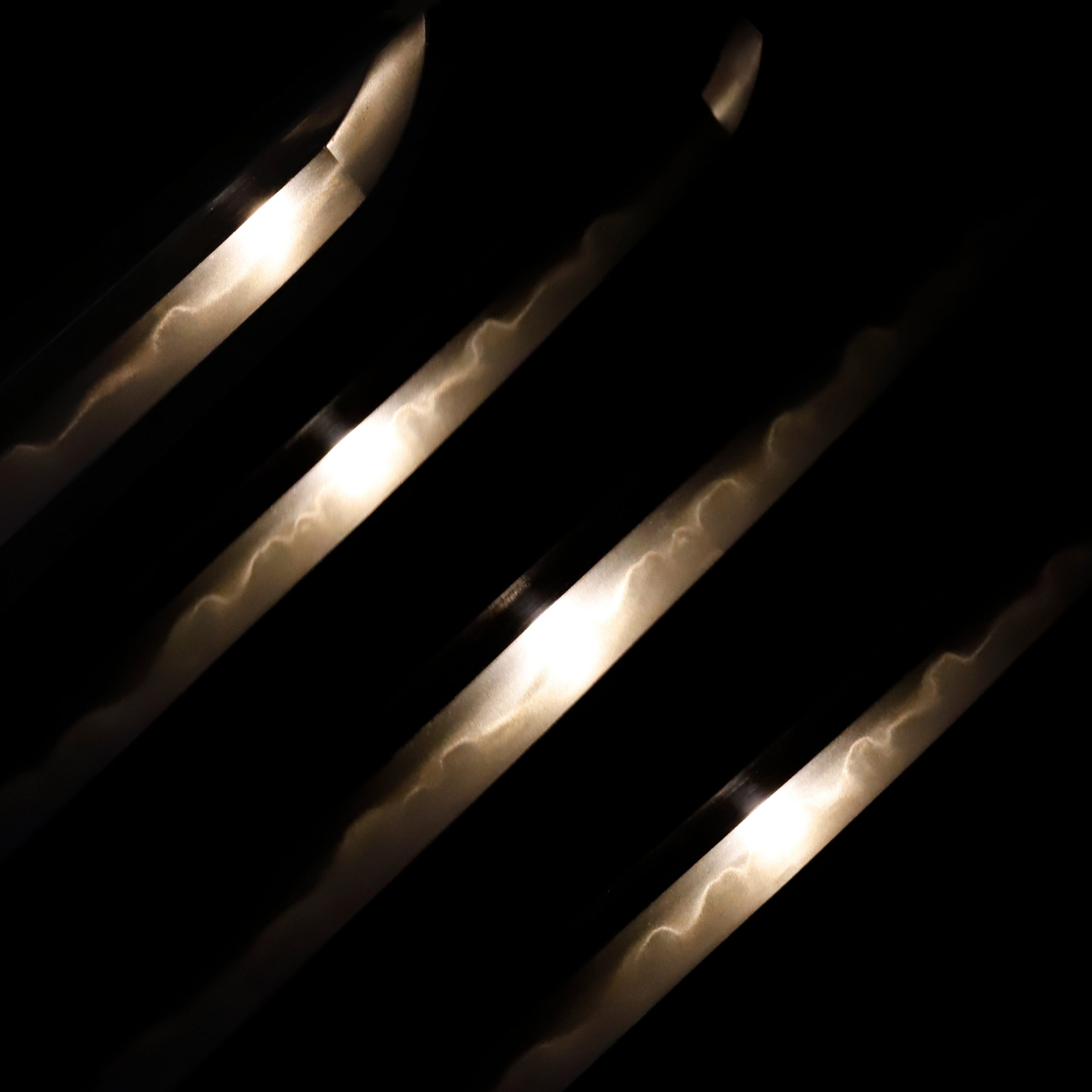
Nakago:Nakago is the tang of the Japanese sword.
Japanese swordsmiths left the black rust on the tang because it prevents red rust while the tang is in its handle. And the discoloration of the tang was created over time, and it is a great indicator for a Japanese sword specialist to estimate when the sword was forged.
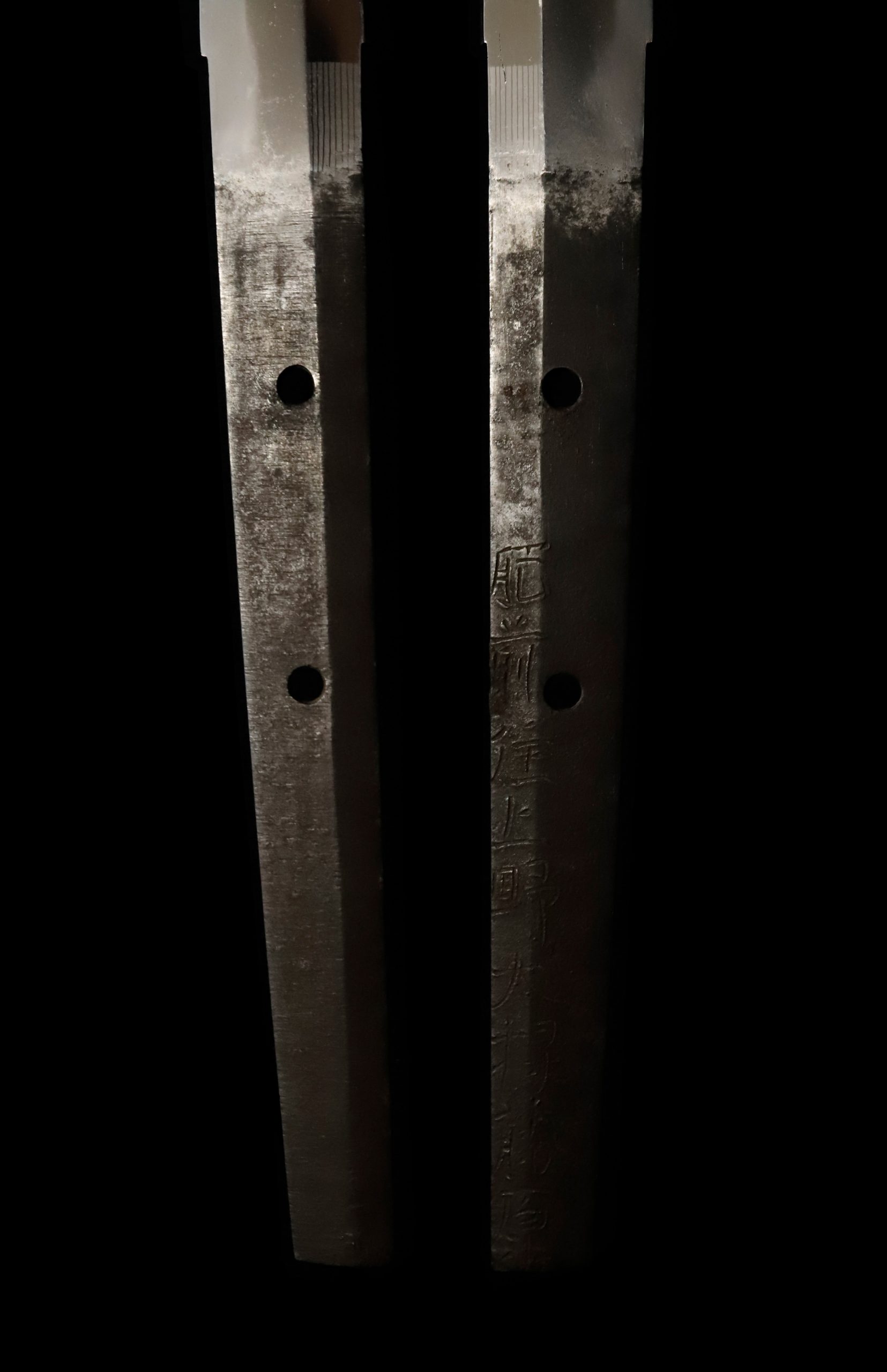
Koshirae: Koshirae is the mounting of the Japanese sword. There are several parts that consist of Koshirae such as Saya(Scabbard), Tsuka( Handle), Tsuba(Handguard).
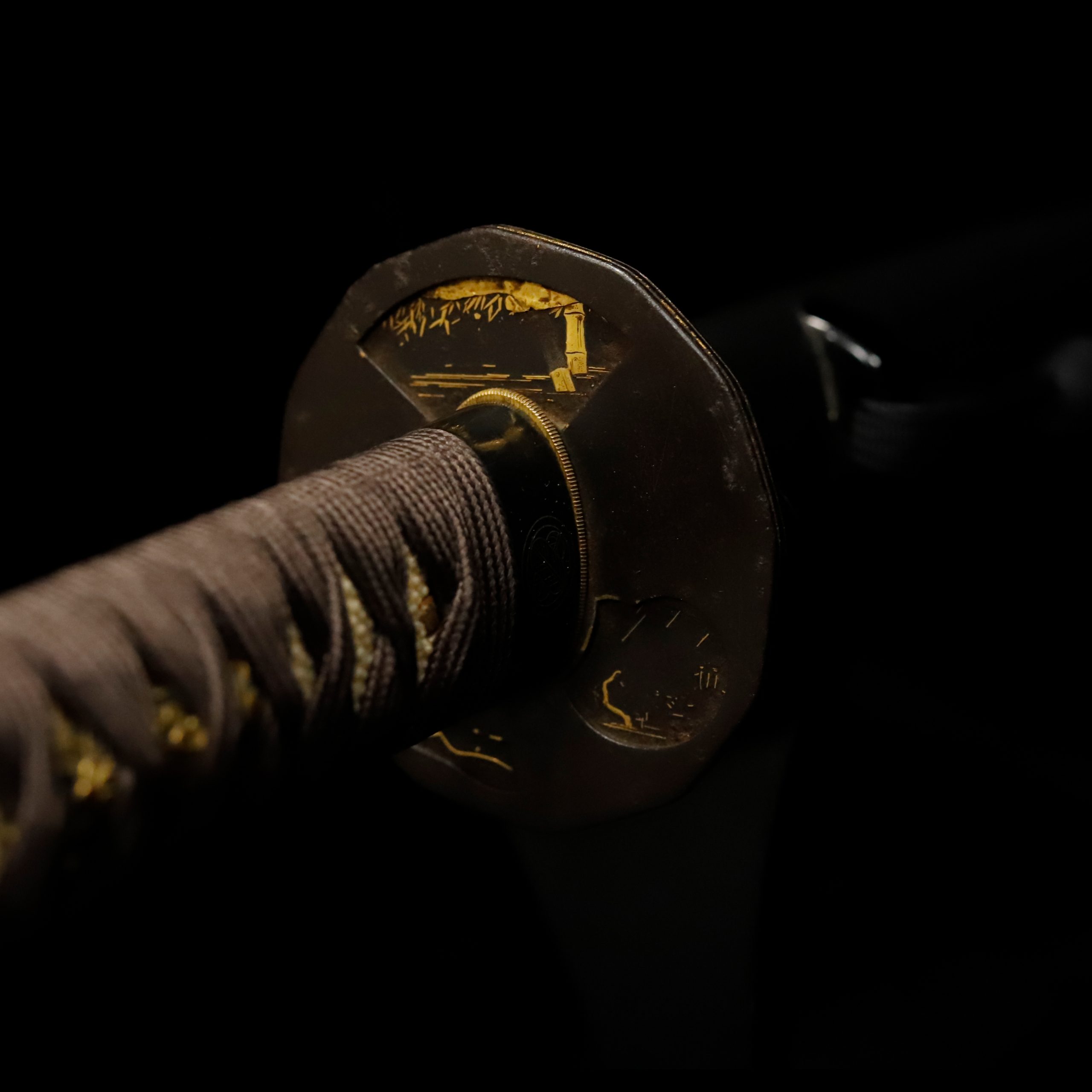
Fuchi-Kashira:A pair of matching sword fittings that cover the upper and bottom parts of its sword hilt.
You would find the symbol on this Fuchi Kashira. We guess that it is the family crest of this sword’s former owner. This mark is called the Taka-no Hane (鷹の羽根, the hawk’s wing) pattern. Since hawks fly swiftly and are regarded as the symbol of strength and dignity, many Samurai families loved the hawk motif itself. Furthermore, its wings were used for one of Samurai’s primary weapons; the arrow (They put hawk’s wings as arrow’s feather). The arrow itself is reminiscent of victory or defeat, battlefield; it is not difficult to imagine that Samurais also liked the hawk wings attracted to arrows. Also, in Japan, there is a traditional custom that is called Takagari (鷹狩り, falconry). Hawks would get used to humans if they came in contact with it properly. Humans and hawks had a deep connection in this tradition. The Taka-no Hane pattern was appreciated not only by Samurais but also by court nobles. Still today, various family crests use this bird wing’s motif.
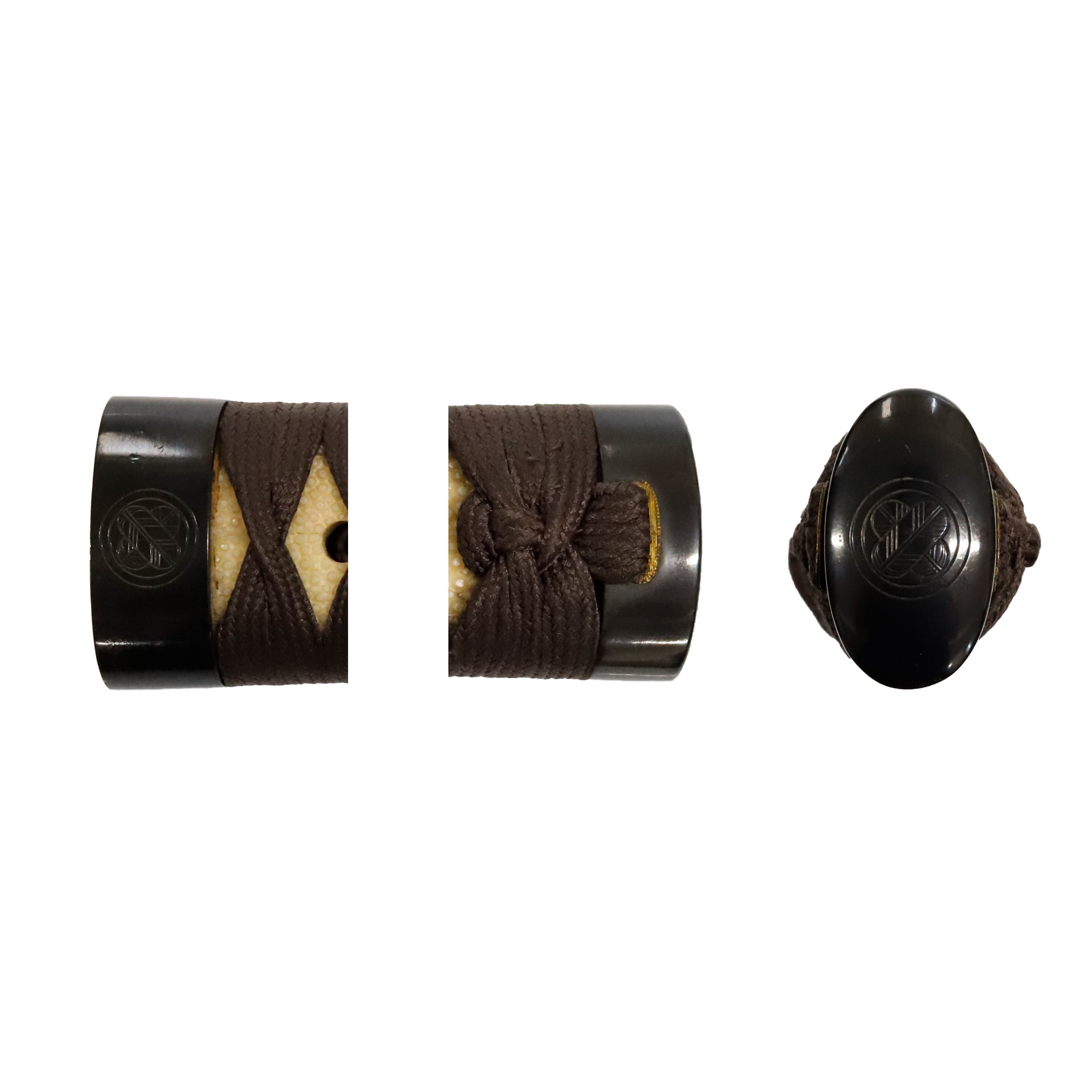
Tsuka and Menuki:Tsuka is the handle of the Japanese sword and Menuki is its decoration.
Seeing the shape of petals, the Japanese apricot blossoms are the motif of this Menuki. It seems the golden metal was initially applied to this Menuki. This flower begins to bloom in winter that snow still covers its tree. Therefore, people thought it tells the arrival of spring. Same as cherry blossom, Japanese apricot blossom has been appreciated for a long time in Japan. People enjoy its adorable petal shape and scent, gracefully branched tree, and compose many poems. As it comes out in the cold season, it symbolizes the power of perseverance and vitality.

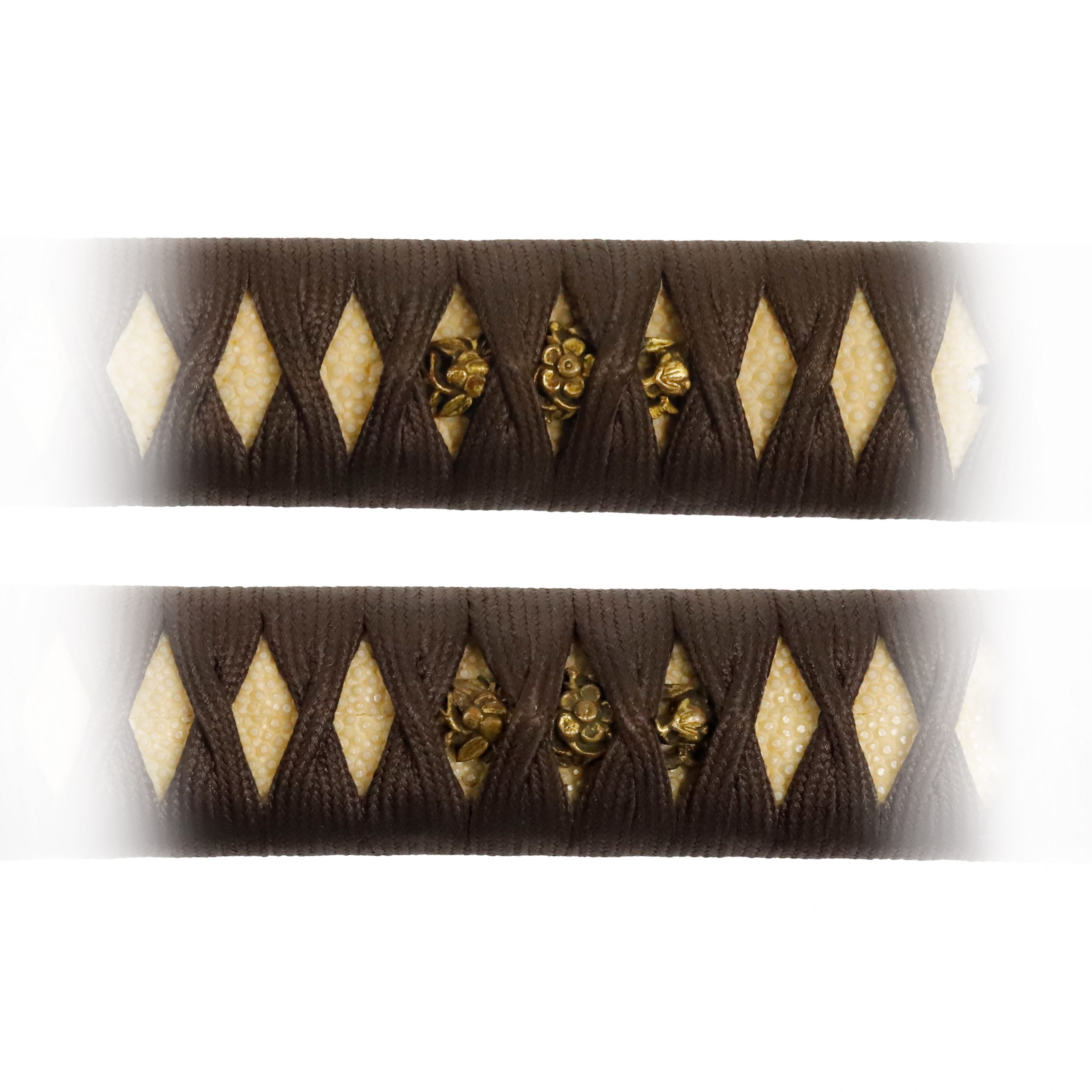
Tsuba and Habaki:Tsuba is the handguard for the Japanese Sword and Habaki is the equipment to make the blade not touch its scabbard inside. It prevents the blade from getting rusty and chipped.
This Tsuba is made from iron and has a Kozuka hole. Dents were made in various shapes, such as a fan, a piece of cloth, etcetera. And different motifs are inlaid with gold (or brass) inside of each dent. For example, bamboo and the Ume tree are designed on the front. On the backside, you would find the waterwheel and chrysanthemum.
Bamboos grow neatly towards the sky, and it is vital that this motif represents nobility and strength. Besides, the bamboo breaks straight, but its content is hollow; people thought it shows innocence. According to a Chinese legend, Houhou (鳳凰, Fenghuang) eats bamboo fruits; therefore, bamboo has been considered a sacred plant. Also, as it keeps its green color even in cold winter, people thought the bamboo pattern shows eternity and longevity. We would say that the bamboo pattern has been one of the familiar designs for Japanese people since ancient times.
A long time ago, the chrysanthemum was used as a medicine for obtaining a long life, and it was brought to Japan from the Continent with this thought in the Nara period (648-781). Chrysanthemum is one of the flowers which symbolizes fall, and people have appreciated it very much since ancient times. As its petals form radially, the chrysanthemum has been likened to the sun. That is why this flower pattern is treated as the symbol of perpetual youth and longevity or good health.
We hope you will enjoy these stories about motifs when you see the Tsuba.
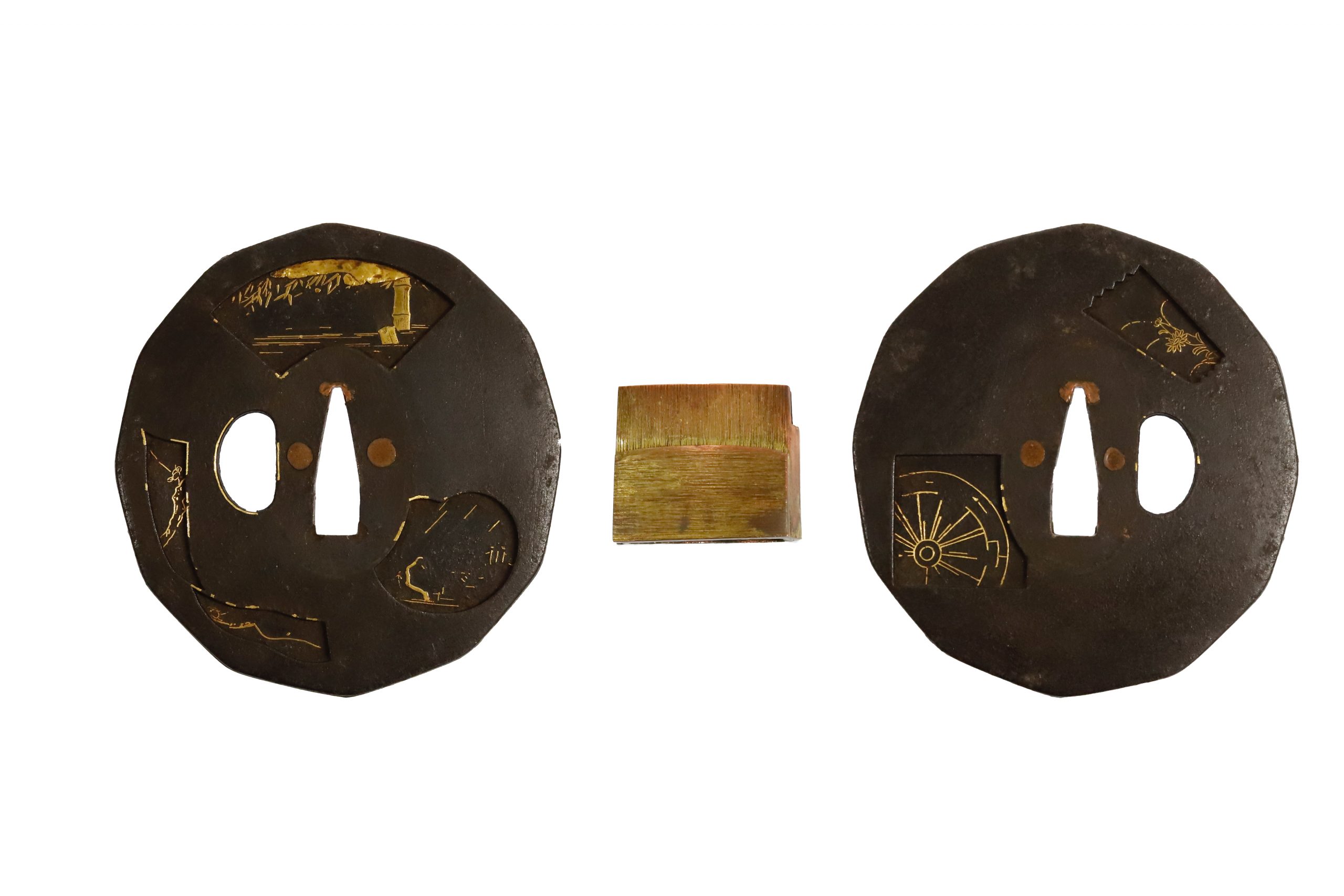
Saya: Saya is the scabbard for the Japanese sword.
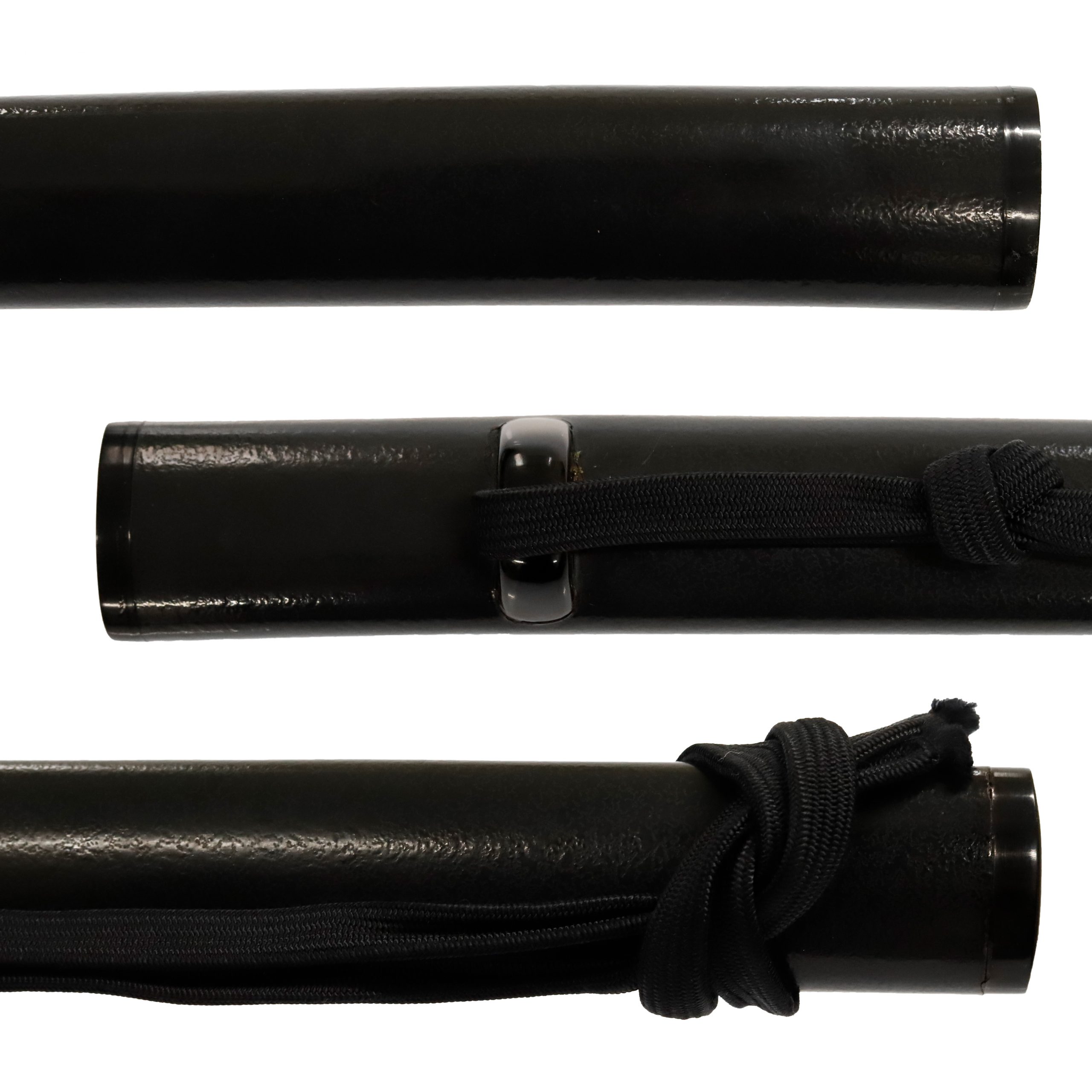
Authentication Paper:NBTHK Hozon Certificate for the blade (No. 335305)
NBTHK, also known as Nihon Bijutsu Touken Hozon Kyokai (the Society for the Preservation of the Japan Art Sword), is one of the oldest Japanese sword appraising organizations in modern-day Japan. They authenticated the blade on July 7th in the 6th year of Heisei (1994). They appraised it as Hozon Touken, the blade worth preserving for Japanese society. The purchaser will receive this original certificate as well. We can also translate what is written into English and make a PDF file for your record if you request.
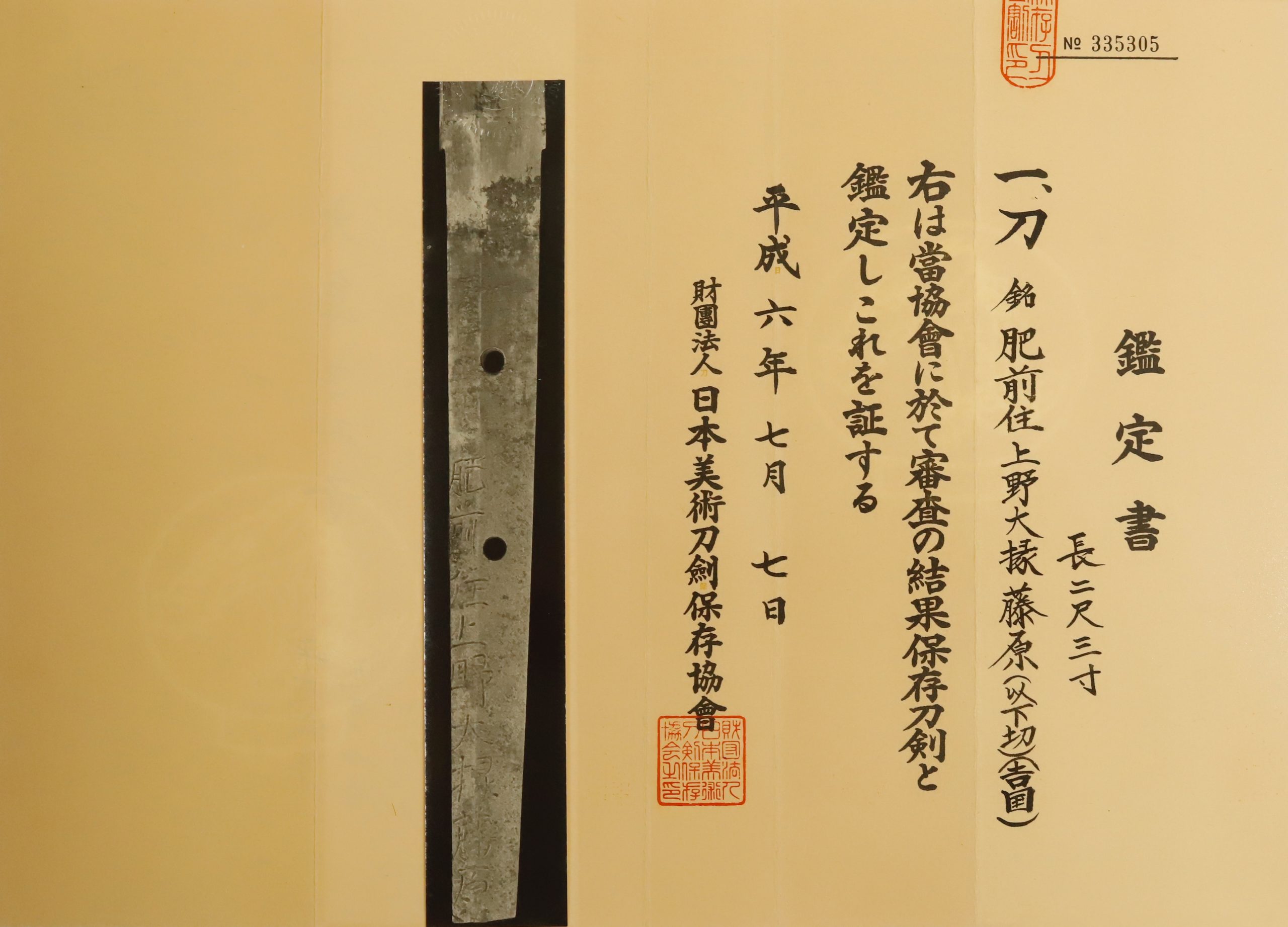
Registration Number : Fukuoka 88272
The Board of Education in Fukuoka prefecture issued a registration paper for this sword .It is called Jyu Token Rui Torokusho(銃刀剣類登録証). Bunkacho(The Agency for Cultural Affairs) acknowledges a Japanese sword with this paper as a work of art.
The sword needs to be traditionally hand-forged and made of Tamahagane carbon steel to be registered in the system. With this paper, its owner in Japan can legally own an authentic Japanese sword. Based on this registration number, we will apply for its export permit.
This paper will need to be returned to the board of education when the sword is being shipped abroad, but you can receive a copy of it. An English translation of this registration paper is available on request.
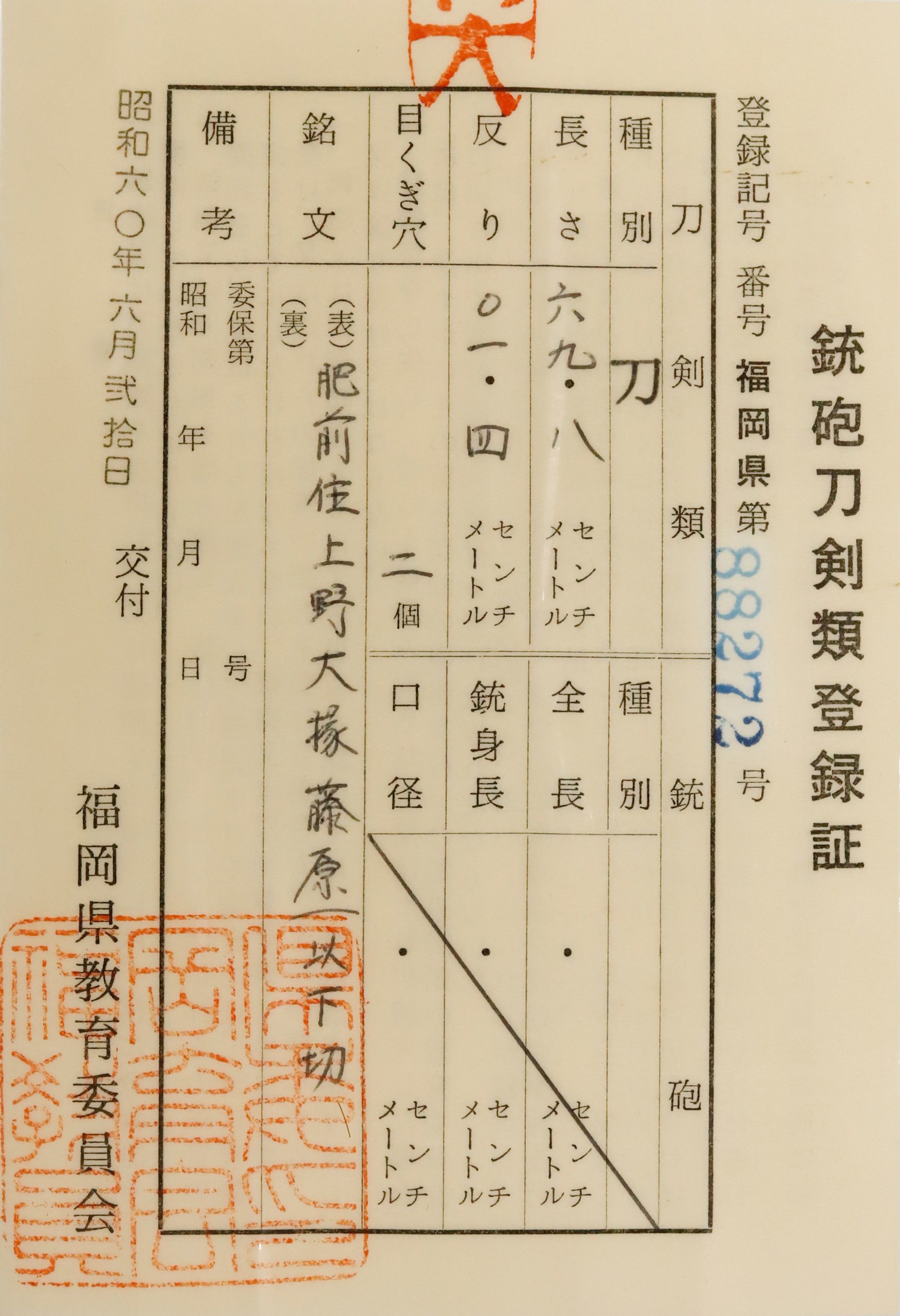
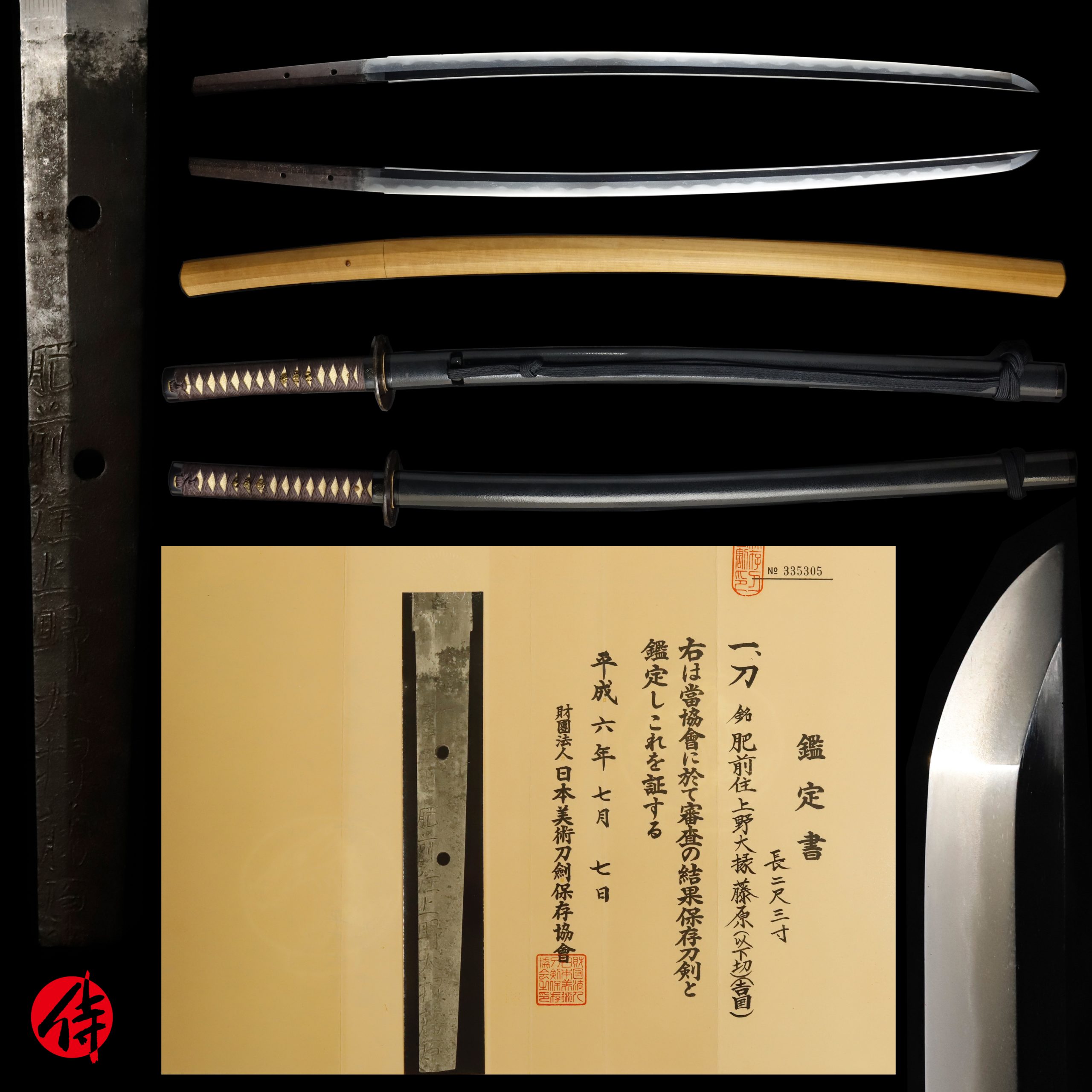
—————————————————————–
【About us】
Samurai Museum is located in Tokyo, Japan, exhibiting antique artifacts related to the Samurai history. Samurai Museum Shop is the place for those who are interested in Japanese culture and craftsmanship. We deal with antique Samurai swords/armor, traditional crafts made in Japan and so on.
【Japanese Sword& Export Process】
The Japanese swords we deal with are hand-forged edged swords made in Japan. It was made from the traditional carbon steel called TAMAHAGANE(玉鋼). Samurai Museum is familiar with the proper legal procedure for an antique/ authentic Japanese sword to be exported from Japan. We have sent more than 350 Japanese swords to amazing owners who appreciate its historical value.
Each Japanese sword is registered under the Agency for Cultural Affairs and the Board of Education in Japan.They issue a registration paper for each Japanese sword for its owner in Japan to legally possess it. The Japanese sword with its registration paper means it was traditionally hand-forged in Japan.
To legally export the sword from Japan to other countries, we will have to apply for its permit to the Agency for Cultural Affairs(Bunkacho) and return the original registration paper to the Board of Education. It normally takes around 2-4 weeks to receive this permit after submitting required documents. And we would like you to expect at least 1-1.5 months for your order to arrive at your given address after you ordered. For more detailed info, please click here.
It is allowed for residents in Japan to own authentic Japanese swords without a special license as long as they come with registration papers. Please feel free to contact us if you are a resident of Japan, whether temporarily or permanently. We will also assist you when you leave Japan and need to obtain the export permit.
【Payment Method】
We accept payment through Stripe (Credit card), PayPal, Apple Pay or ChromePay, all of which are secure payment methods. Also, you don’t need to make an account on Stripe for the checkout. If you prefer other payment method, please contact us. After confirming your payment, we will apply for an export permit. You may either pay in JPY, USD, AUD, CAD,EUR or GBP. The price is set in Japanese Yen. Prices in other currencies are automatically calculated based on the latest exchange rate.

【Shipping】
We have shipped authentic Japanese swords to the USA, Canada, Mexico, UK, Germany, Switzerland , France, Hong Kong and Australia. If you don’t live in these countries and like to order, please contact us first before making a purchase. We offer Free International Shipping as long as we can send antique Japanese swords by either EMS or FedEx(Canada).
We normally ship by EMS(Express Mail Service) provided by Japan Post. When we receive an order from the Canada we will use FedEx instead as EMS temporarily stops shipping from Japan to those countries due to COVID-19.
We will send you a tracking number for your order as soon as we hand it to the post office/FedEx. We will put 100 % insurance on the shipping document without any extra charge. Based on the total amount, there might be a duty tax or other fee for you to pay, depending on the countries. We use package cushioning to protect the item and put it in a PVC pipe, which is one of the most secure packages because of its durability.
It will normally takes 5-14 days for the item to arrive at your given address after we dispatch it. Time of delivery is estimated as accurately as possible by the carrier but does not take into account any delays beyond our control such as by inclement weather, post office holiday seasons.
* If you live in Australia and like to purchase an authentic Japanese sword, please click here to know the detail.
*Please keep in mind that due to the spread of COVID-19, there might be delays in shipping. If you like to know the detail about shipping, please feel free to ask us.

【How to make sure the condition】
Please keep in mind that what you are going to purchase is an antique item. We uploaded high resolution photos for you to check its condition thoroughly. If you like to see more photos with different angles, please feel free to contact us. We will be happy to send them to you so that you can make informed decision. It is essential for us to know that you are happy with your choice of a sword. and we are prepared to use the best of our ability to serve you.
【How To Contact Us】
Please contact us through email, Facebook Messenger or Live Chat if you have any questions. You can find each icon on the right side of the website. Please click one of them to reach us. We will reply to you within 1-2 business days.
【The Art of Nihonto(Japanese Sword)】
Samurai’s history is a profound, eloquent legacy of ancient Japanese warriors in which millions of people worldwide are being fascinated. If you like to find out the art of Nihonto, please click here.
【A Guide to Japanese Sword Maintenance】
After acquiring an genuine Japanese sword, it is also important to know how to take good care of it. Here is the special video for you. Mr. Paul Martin, Japanese sword expert, shows you how to give proper maintenance to your sword. By mastering how to clean the Japanese sword, its aesthetic beauty will last forever.
When you purchase a Japanese sword from us, you can get a Free Japanese sword maintenance kit. It comes with four tools(Choji Oil, Uchiko Powder, Peg remover, Oil Applicator). By watching the video instruction above , you can enjoy learning how to maintain your Japanese sword while appreciating it.


